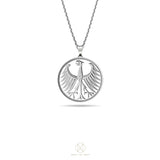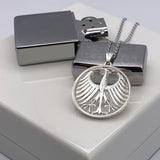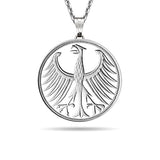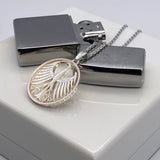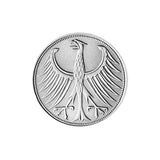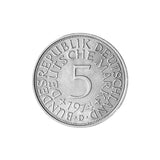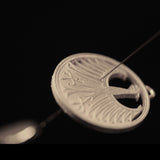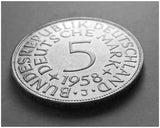The 5 DM Silver Eagle is undoubtedly a West German legend: like no other 5 DM coin, it is closely linked to German history, the post-war period, former Chancellor Konrad Adenauer and the German economic miracle of the 1950s.
The silver fiver coins are the last silver circulation coins of the Federal Republic of Germany and have become a popular collector's item over the years. In the early 20th century, the coin was also known as " Heiermann" (Heierman ) – derived from "Heuer," a sailor's wage.
A total of 19 years of the Silver Eagle were minted at German mints. The first 5-DM silver coin was minted in 1951. From 1956 to 1974, it was minted annually (except in 1962).
5 DM coins made of 625 silver from 1951 to 1974

In 1951, the Federal Republic of Germany began minting coins with a face value of five Deutsche Marks.
These were made of 625 silver and had a gross weight of 11.2 grams. Thus, each silver 5-DM coin contained exactly 7 grams of fine silver. The coin was designed by Prof. Albert Holl.
The 5-DM coins with the year 1951 are the ones with the highest circulation of all silver 5-mark coins. A whopping 79.6 million of them were minted.
Because of the heraldic animal and the silver they contain, these coins were affectionately called “ silver eagles ” by the Germans early on.
Specifications of the 5 DM Silver Eagle
| Weight: | 11.2 g (7 g silver) | Fineness: | 625/1000 |
| Nominal value: | 5 DM (German Mark) | Mints: | D, F, G, J |
| Diameter: | 29 millimeters |
The mint mark on the obverse indicates which German mint the coin was minted in. From 1956 onwards , with a few exceptions, the silver eagle was minted by the following four German mints:
- D Bavarian State Mint Munich
- F State Mint Stuttgart
- G State Mint Karlsruhe
- J Hamburg Mint
The most valuable silver eagle: 1958 J

In 1958, only 60,000 examples of the Silver Eagle were minted at the Hamburg Mint (J). This made the 1958 J Silver Eagle the rarest and most sought-after of the entire coin series. It is currently valued at €4,500 in Brilliant Uncirculated quality .
This makes it (in the appropriate quality) the most expensive silver coin in the Federal Republic, alongside the first 5-DM commemorative coin. However, this issue is also one of the most frequently counterfeited coins in Germany. Therefore, it is recommended to purchase this coin only from a trusted coin dealer.

Discontinuation of the series
The Silver Eagle, also known as the Heiermann, was one of the most popular coins in Germany: many collectors were all the more disappointed when the Silver Eagle was replaced by a new 5-DM coin in 1974.
The reason for the new 5-DM coin was the rising price of silver, which made further minting of the silver eagle too expensive, and the high price of silver threatened to exceed the face value. However, this was only the official justification – there was actually another, equally important, if not decisive, reason:
Reasons for the final demise of the Silver Eagle
The rising silver price was the main reason for the discontinuation of the Silver Eagle circulation coins. Another reason is speculated to be complaints from vending machine manufacturers, as increasing numbers of 5-DM coins were being counterfeited, leading to a significant loss of revenue. To counteract this, the Federal Ministry of Finance awarded the industry a contract to produce a special coin material that could be easily recognized as genuine money by modern vending machines. The choice fell on the "magnetic material" developed by ThyssenKrupp, called "Magnimat." It has a special magnetizable nickel core that could be quickly and reliably recognized as a genuine coin by an electromagnet inside a vending machine. Counterfeiting this material proved to be so technically complex that it would not have been worthwhile for criminals. This finally put a stop to massive coin counterfeiting. This was probably kept secret because there were still some older machines that still accepted the old silver eagles, even though they had been officially out of circulation since August 1, 1975.









